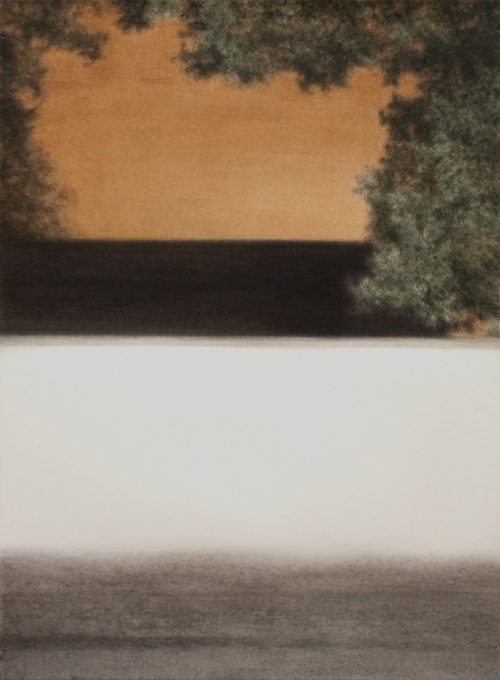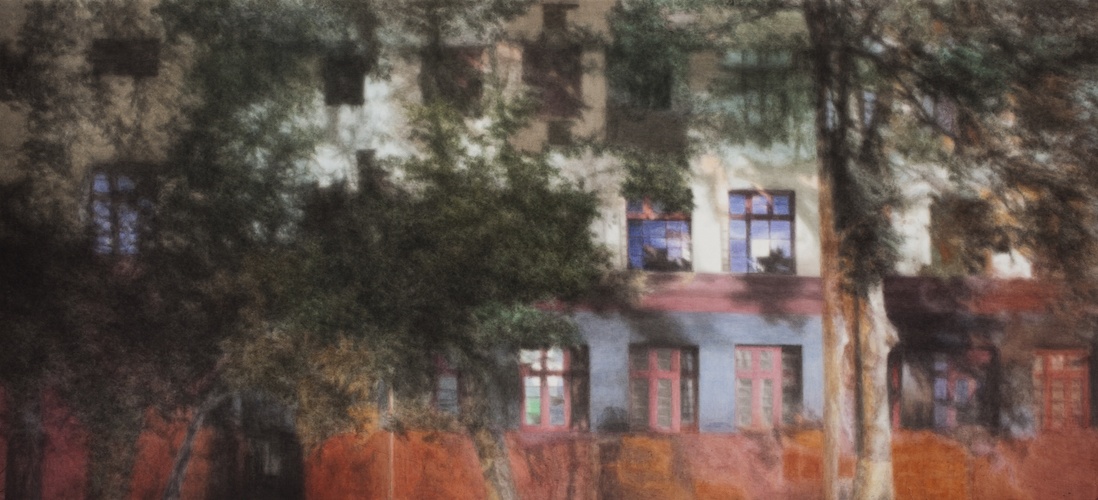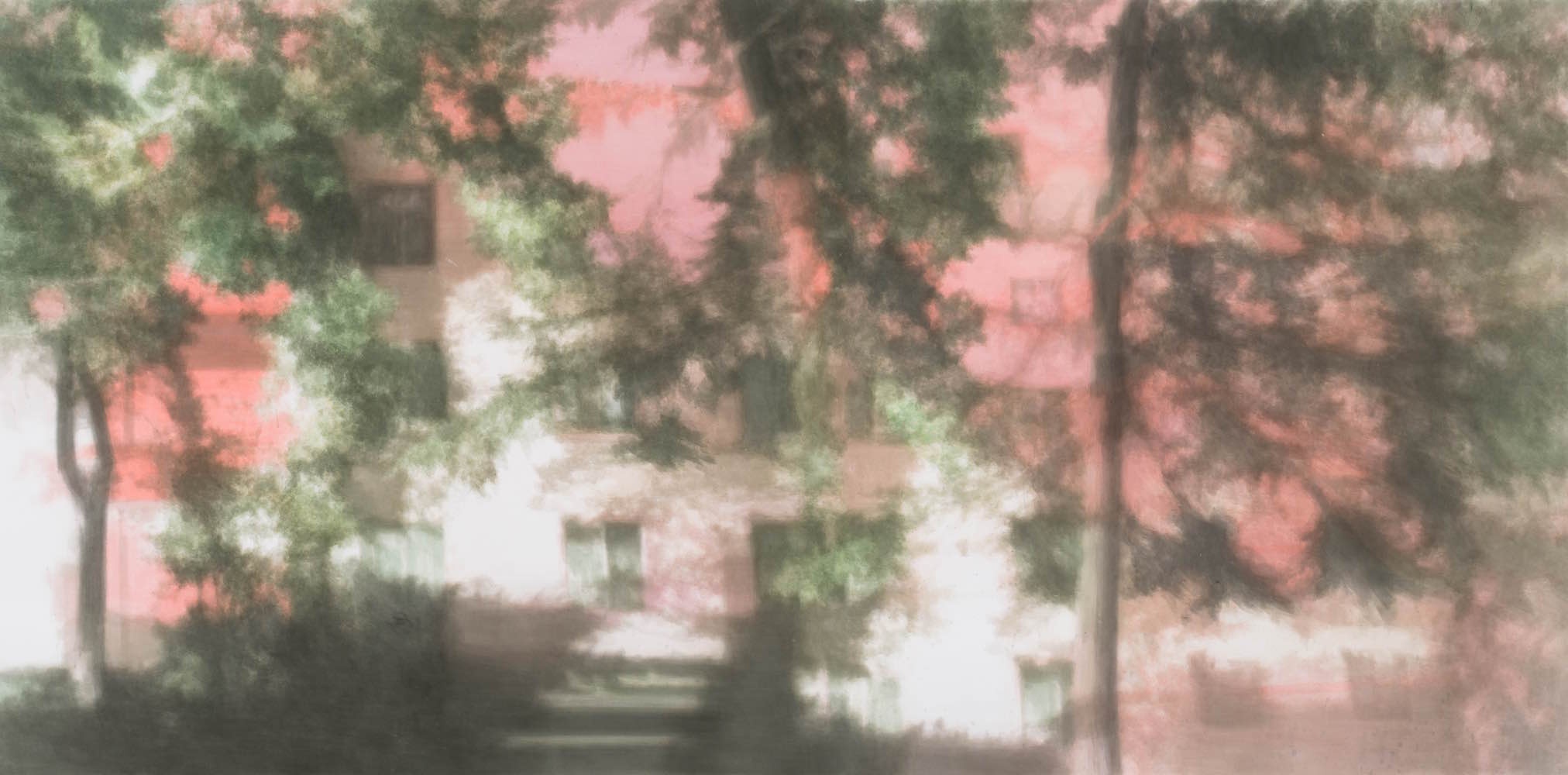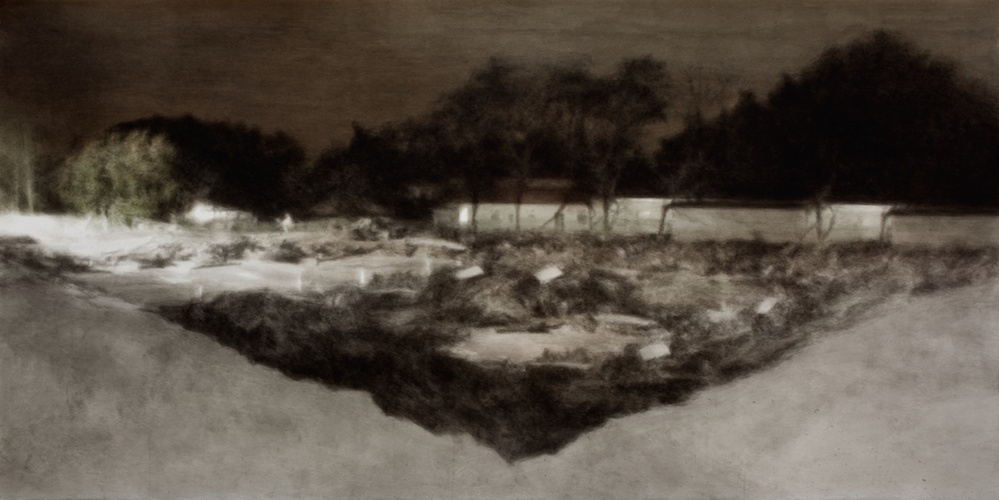I
To those who are well versed in the evolution of modern and contemporary art (both Chinese and Western), Wall (2016-2017), a recent painting by the artist Kang Haitao, may seem somewhat exotic. Its concise geometrics and its gloom, as well as its self-effacing psychological atmosphere, remind us of Rothko’s later abstract paintings. However, the illusory, elusive effect of pale light and colour on the picture, together with the thought-provoking depiction of a wall that itself endures the hardship of exposure, looks obsolete, yet is multicoloured and quasi-hallucinatory, is also tinted with Tuymans’s style of imagistic painting.

Wall, 2016-2017, Acrylic on paperboard, 140 x 243 cm
Evidently, Wall is not an aesthetic compromise between two disparate language systems, because, behind its seemingly eclectic visual language, there lays an obscure but profound social experience, that makes the viewer ‘sigh from the heart’ once they realise its significance. Be it the wall with a timeworn surface, the doors varying in heights, or the extensive marine blue masked by grey, Kang Haitao’s paintings always evoke memories of life – perhaps nostalgic but definitely familiar – an urban life that revolves around factory-affiliated neighbourhoods and public institutions. The reality is that these neighbourhoods and institutions are still found throughout China; however, due to intense social change in the new century, these places have morphed, or faded from the public eye into a kind of marginal existence.
Yet these familiar sights, which were once paid scant attention – that at one time appeared so insubstantial that they warranted only a casual glimpse – are transformed in the painterly language of Wall through an extended period or working and re-working, a sort of aesthetic refinement. These paintings, serene but magnificent, solemn yet imposing, also present a mysterious psychological atmosphere and instill a brooding anxiety into what otherwise could be a ‘casual glimpse’.
II
… ‘I’ am only a person who records without judgment or reflection. The process of aesthetic judgment and analysis has been replaced by my senses as I am living in it… I record and I narrate. At this moment, there are no longer any sober observers. Observation is directed towards the discontinuous memory flashing back to my inner mind… The disorderly memories and the things being transformed into memories are all objectively crystallized into the very moment which has to be registered…[1]
The words above are excerpted from Kang Haitao’s personal statement, Introversion and Meditation. It was not until ‘Introversion and Meditation’ – Kang’s 2009 solo show in Beijing – that his paintings began to attract more attention. At that time, the New Wave art movement in China, vigorous during the 1990s, had already subsided. The ‘Art of the Post-70s’, a one-time fashion and short-lived triumph that implied adolescent rebellion and the peculiar taste of language stretching from the ‘Young and Cruel Painting’ to the ‘New Cartoon Generation’, was increasingly criticized and questioned. Kang Haitao’s practice sits aside from these three movements in a unique position.
Read from this context, Kang’s words clearly manifest his self-awareness of his own artistic creation: Kang’s ‘landscapes’ are ‘not objects obtained through observation’ they are products of his inner experience rather than mere visual impressions. ‘I am only a person who records without judgment or reflection.’ This means that the representation of the real is not the only source of his inner experience – by pitting ‘record and narrate’ against ‘meanings and values’, Kang Haitao distinguishes his own art from various approaches to art emphasizing the importance of definite ‘meanings and values’ – either the traditional mainstream realism, or the modern art movement since the 1990s which has rebelled against, deconstructed and become estranged from mainstream values.
However, different from striking and stunning social scenes that are usually associated with expressions like ‘I record and I narrate’ and ‘the moment which has to be registered’, what Kang records are silent landscapes. Landscapes, although seeming ordinary and everyday to others, always arouse extremely strong emotions in him: “Once I close my eyes, [landscapes] will emerge in front of me, just like nightmares that are hard to dispel. So the only way is to present them.”[2]
III
Kang Haitao’s early nightscape paintings were indeed nightmarish in a certain way. The thickness of the dark night, the flickering dim lights, and the illusory and crooked trees – all are turned into a touching yet unnerving final tranquility by virtue of the peaceful remnants of a violent combustion.

Wall, 2010, Acrylic on paperboard, 110 x 77 cm
A different Wall, painted in 2010, demonstrates a considerable change: unlike the previous visual illusion that tried to appear ‘objective’, this painting explicitly highlights some abstract elements. Bushes, parapets, and pavements were painted in geometric shapes; light and shadows were compressed into highly succinct blocks of colour; there were also fewer brushstrokes and reduced palette. Another direction of change has been displayed in House in Colour (2012). Trees in pine green, glass windows alternating between umber and indigo and walls in white, pewter and maroon – amid them are the fluctuating dappled shadows of trees, deep or shallow – together constructing a poignant and poetic everyday scene.

House in Colour, 2012, Acrylic on paperboard, 92 x 201 cm
In Kang’s landscape paintings since 2013, these two directions of transformation have both been intensified as well as integrated. Delicate and expressive paintings like Night, Bushes, Time are filled with concise and abstract tones; whereas works that seem to intentionally focus on the flavours of abstraction, like Sublime Form, Shadow 1/2 and Unexpectedness of Form, also somehow articulate the artist’s sensitivity to everyday experiences.
Kang Haitao’s recent paintings present landscapes and objects within a laconic and insubstantial visual atmosphere. Yet they are transformed into sophisticated images that contain numerous thoughts and ideas. This change is a natural development of Kang Haitao’s deepening experience, self-reflection and breadth of vision rather than merely from an aesthetic decision or redirection.

Memory of Light, 2016-2017, Acrylic on paperboard, 182 x 384 cm
House in Colour and Memory of Light (2017) for example, share similar visual motifs, namely, the whirling branches and the shadows of trees falling on old buildings. The palette choices of House in Colour is primarily natural – the pine green of the leaves and wood tones of branches; it also features richer stylistic details (windows, walls, branches, shadows of trees etc.,) and subtler layers of light and shadow that reflect the artist’s experience of everyday scenes. The colours of Memory of Light, however, are more the ochre of walls and the detail and layers of light and shadow are less intricate. However, in the serene, dreamlike and rather splendid visual atmosphere, the artist’s perceptive awareness of site turns into deeper and more imposing experience of the social and life-experiential – as is suggested by the painting’s title.
IV
When Kang Haitao made the turn to landscape painting around 2005, he went through a period of deep introspection, concerned with the interrogation of the ‘contemporariness’ of his work. Between academic value and his own inner experience, he opted for the latter without hesitation. From his initial nightmarish nightscapes, to the abstract or faded everyday landscapes, and to his recent imagistic landscapes that absorb the sophisticated experience of viewing pre-existing imagery, all these are the landscapes seen through the eyes of a restless witness.
 Ruins, 2010, Acrylic on paperboard, 200 x 101 cm
Ruins, 2010, Acrylic on paperboard, 200 x 101 cm
Except for Ruins (2010), Kang Haitao erases the realistic elements and motifs that may impose haunting nightmares upon his audience. How are the passions for ‘witnessing’ transformed into such obscure poetic qualities? It is closely connected with the sense of hopelessness that seems to pervade China in the 21st century – first the disillusionment of idealism, next the failure of sarcastic deconstruction and criticism and finally the loss felt after the collapse of western cultural idols. This hopelessness is so powerful that all the passion for witnessing distinct meaning and value could be lost; however, obscure and profound poetic experiences, when strong enough, such as those presented in the work of this art, can help resist the ruthless corrosion of nihilism.
From this point of view, Kang Haitao’s thought-provoking landscapes are the spiritual narratives, full of wisdom and passion, of what many feel is a ‘voiceless’ era.
May 12th, 2017

